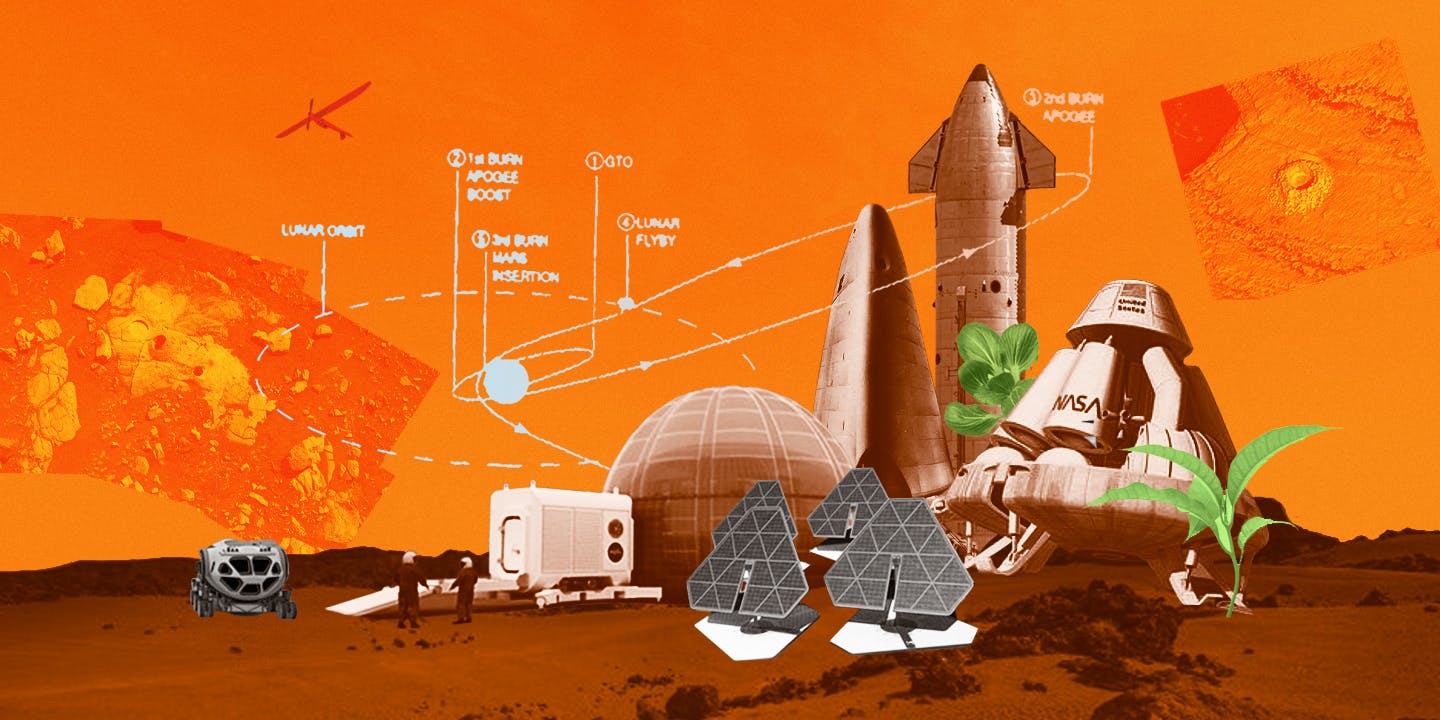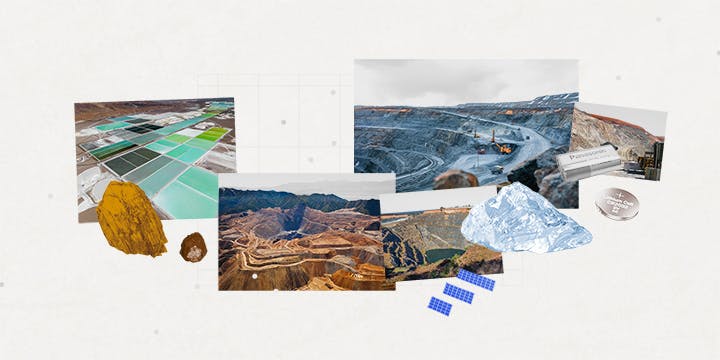One of the biggest unanswered questions within the scientific canon is whether long-term survival and biological evolution are possible beyond our own planet.
We have a hunch that it’s possible. Indeed, most of our science fiction and hopes for the future rely on this being a real possibility. Making humanity an interplanetary species has been a tacit goal in the backdrop of aerospace work. It’s been the dream and fascination of nearly every engineer who works on systems intended to take humans beyond the orbit of Earth.
The project of making humans an interplanetary species is already a century in the making. Today, however, few appreciate that it’s a project we’re very lucky to even be able to undertake in the first place.
It’s an accident of the universe that the Earth’s gravity is just low enough to allow our propulsion technologies to escape its orbit. We’re also fortunate to exist in a time with technology powerful enough to carry us all the way to a different planet. And it’s fortuitous that we have somewhere to go. The planet Mars happens to lie within the habitable zone of the solar system. It is the only such planet, outside of the Earth.
Indeed, many prominent thinkers from Robert Zubrin to Elon Musk and Casey Handmer have asserted that not taking advantage of this unbelievable alignment of opportunity would be a profound waste of human potential.
For now, we live in a moment when our societies and governments can coordinate the resources and talent to get an operation of this scale off the ground. But it might not always be this way. Establishing a human presence on Mars will require decades of concerted efforts, which means the most prudent time to start work is now.
Turning the Red Planet Green
The most realistic plans for humans becoming a multi-planetary species have centered around Mars. Not only is Mars relatively rich in natural resources compared to other planets in the solar system, it has a number of features that make travel to it, and survival once there, just barely possible. It’s almost as though it was divinely placed next to us, a temptation for humanity to venture forth into the cosmos.
At the moment, however, Mars is deeply inhospitable to life. Average temperatures fall around -60 °C, and at the extremes reach -144 °C. The atmosphere is so thin that it produces nearly zero pressure, which means that the surface of the planet is essentially a vacuum. What little gas does exist in the atmosphere is mostly carbon dioxide, which is poisonous if inhaled by aerobic life forms like humans.
However, this news should not deter us, because it comes with many silver linings. In the first place, Mars didn’t always use to be so treacherous. There was a time, many millions of years ago, when it had many flowing rivers and even deep oceans. We know this because we can see the canyons that these once powerful flows carved into the planet even today.

Source: University of Chicago
The liquid water that existed on the planet is now frozen and trapped underneath mounds of red Martian dirt, or “regolith”. The existence of water, even if it is frozen and not immediately accessible, is critical to the Red Planet’s potential to sustain life. Without it, a permanent settlement on the planet would be infeasible if not impossible.
Beyond water, Mars has nearly every element we could need to produce food, fuel, plastics, and other materials right on the planet. In addition to carbon, hydrogen, and oxygen, it also has vast stores of nitrogen, without which agriculture would not be possible. Although we don’t have a complete accounting of the minerals present in the Martian regolith, researchers are optimistic that volcanic activity produced a number of valuable mineral ores trapped beneath the surface.
In the second place, we know from experience here on Earth that altering the climate of a planet is in fact very possible. If we were to produce an intensified greenhouse effect on Mars and thicken the atmosphere, the planet could be warmed up significantly — a critical step in making it habitable.
Imagine restoring the flow of Martian riverways and melting its frozen oceans. Once there is liquid and stable water on the surface, nearly all the key ingredients for a thriving biosphere would be in place. The final step to truly transforming the planet would involve saturating the Martian air with enough oxygen for humans to breathe without the aid of a mask. The ultimate vision is nothing less than turning the red planet green.
Science tells us that all of this is possible. Unfortunately, seeing this vision through will require thousands of years. No one alive in our generation, or the next, will see Mars in such a state, but that’s no reason to not build towards this goal.
Some of our greatest accomplishments as a species took many lifetimes to complete. The first architects of the Great Wall of China didn’t live to see its final stone placed 2,000 years after construction began. Still, they had created the designs for a project of species-level significance. Similarly, should humanity ever succeed at turning Mars into a viable, thriving biome, it would stand as our civilization’s crowning achievement.
Mars Mission Architecture
Executing this mission will all come down to planning. Given the extreme capital and time investment required to settle Mars, enormous care will need to be taken to ensure that resources are used efficiently and that the amount of work that needs to be redone is minimized.
At the heart of the Mars project, then, is the mission architecture. The mission architecture takes into account all the constraints within which engineering work will need to be done and sets the contours of the project. All design decisions will flow from this, which is why companies like SpaceX already employ numerous scientists whose jobs are to design as streamlined and reliable a mission plan as possible.
Mars mission architects are the architects of our science fiction future. The task before them is fascinating. Engineers have already succeeded in building advanced life support infrastructure to assist thriving societies on Earth. Now, they face the challenge of repeating this task, albeit on a new planet with supremely different attributes.
Knowledge of what these attributes are, exactly, has come from decades of robotic missions. Though half of all missions to Mars have ended in failure, the United States successfully deployed 25 satellites, rovers, and landers to the planet since the 1970s. The Mariner 9, flew by Mars in 1971 and showed some of the first clear images of the planet’s ancient river canyons. In 1996, the Mars Global Surveyor found that Mars doesn’t have a global magnetic field, and it also made the crucial discovery of carbon dioxide ice in the planet’s southern polar cap.
The Mars Reconnaissance orbiter, launched in 2005 and still operational today, used a radar sounder to identify the location of subsurface ice water. MAVEN, another operational orbiter launched in 2013, has been taking measurements of the Martian atmosphere while Perseverance, the most recently deployed rover, is essentially a full-stack science lab on wheels. Alongside drilling into the subsurface and storing rock samples in a cache for future collection, Perseverance has an onboard experiment called MOXIE which demonstrates the ability to produce oxygen from the carbon dioxide-rich air.
Despite the wealth of knowledge we’ve accumulated about Mars from previous unmanned missions, there are still many unknowns about the planet. We have never, for instance, retrieved any Martian material back to Earth. As a result, we don’t yet know whether important elements like sulfur, phosphorus, sodium, chlorine, potassium, or selenium are present on the planet and, if they are, in what quantities.
Plugging these gaps in our knowledge, and ascertaining the precise nature of the opportunity available on Mars is one of the greatest motivating drivers for a manned mission to Mars. However, there is still one key mission constraint that must be worked out before sending any humans there, and that is selecting the location of the first Martian base. Since navigation to and around Mars will be dangerous and energy-intensive, the shrewd selection of a base is of the utmost importance.
It is critical that the base be strategically located close to critical resource stores, the most important of which is water. Water, which will need to be mined and melted, will be required for much more than providing humans something to drink. It will also be broken down to provide a source of oxygen and produce copious amounts of hydrogen required for the downstream production of fuel, like methane. In short, water is Martian gold and any base will need to be near a lot of it.
Outside of picking a spot with a massive repository of frozen water, there’s growing consensus that a base should be placed near the equator of the planet. The rotational speed of planets is highest at their equator, which means that rockets launching from this point get a significant boost from the planet’s rotation. Given that the base is where spacecraft will launch from, locating it near the equator helps economize on the use of propellant. This is important since resources will be very scarce to begin with. Luckily, there are a couple of known “glacier-like forms” around the Martian equator that might be good candidates for a base. However, more investigation is required to come to a final decision.

Source: Space
Once the problem of a landing zone is solved, the overall mission architecture will likely involve three steps:
- Step one will be a substantial uncrewed expedition to Mars. Its goal will be to deposit critical infrastructure at the base and employ robots to test out critical technologies essential to the survival of a manned mission.
- Step two will be the first manned mission to Mars. Its goal will be to build out the key infrastructure necessary for survival on the planet and conduct critical experiments to ascertain the viability of sustained life on Mars, the possibility of agriculture, and much more.
- Step three, if the first two steps prove successful, will be a continued expansion of the settlement on Mars, including Martian industry and agriculture, with the ultimate goal of making the colony self-sustaining over the long term.
Getting to Mars
Mars is far away. The planet’s trajectory around the Sun puts it some 400 million kilometers away from Earth at the farthest point, and some 60 million kilometers at its closest. Any communications sent from Earth, traveling one way at the speed of light, would take anywhere from four to twenty minutes to reach it, depending on Mars’s position.
In 1925, the German mathematician Walter Hohmann calculated that the optimal time to travel to Mars, in order to make the most efficient use of fuel, occurs once every 26 months when the two planets are conveniently positioned. The goal of a Hohmann transfer between Earth and Mars is to launch a rocket off of Earth’s surface on an arced trajectory that will intersect with Mars. Using modern propulsion systems, a spacecraft can complete this journey in around six months.
In general, the journey to Mars is composed of three distinct phases, all of which come with significant engineering challenges. These are:
- Launching off the Earth’s surface and into orbit
- Making the journey toward Mars and
- Executing a successful landing on the Martian surface.
As mentioned earlier, we’ve already succeeded in sending satellites, rovers, and landers to Mars. However, even the task of sending the Perseverance, which is essentially a science-lab-SUV weighing about 1,000 kilograms, to Mars will look like small potatoes compared to the work that will be required to guide and land something like a 200-ton Starship on the planet.
The first step is launching the spacecraft off the Earth’s surface. As we discussed in our rocketry piece, rockets must do this in stages since lifting a huge amount of mass into Earth’s orbit will use up most of the rocket’s propellant. NASA’s Perseverance, for example, was launched into orbit on a capsule atop ULA's Atlas V rocket. Once it reached orbit, the capsule separated and completed the rest of its journey to Mars using solar-powered thrusters. However, this technique won’t work for a larger ship like Starship.
The most viable strategy for achieving a mission to Mars has been designed by SpaceX, and it relies heavily on the ability of its spacecraft to refuel in space. Once launched into orbit by a larger booster rocket, which in SpaceX’s case is the Super Heavy, the upper stage, or Starship, will be refueled in orbit by a tanker.

Tankers will be other Starships filled entirely with fuel, residing in the Earth’s orbit with the express purpose of refueling other ships. SpaceX is currently designing techniques that will allow the two ships to rendezvous in orbit to successfully perform a refueling.
Once filled with enough propellant in orbit, the Starship will begin its six-month voyage to Mars. It will expend roughly half of its fuel to fully exit Earth’s orbit and enter an elliptical orbit that takes it straight to Mars.
It is on the approach and descent into Mars that the fuel accounting will become interesting. In order to transfer from the elliptical orbit into Mars’ orbit and eventually be captured by its gravity, it will need to slow down significantly by thrusting — that burn expends nearly as much fuel as it took to fully exit Earth’s orbit in the first place.
Once the Starship enters Mars’ orbit, the third phase of the journey begins — landing.
Landing rockets on Earth is significantly easier than doing so on Mars because of Earth’s thick atmosphere. Drag induced by this thick atmosphere slows the speed of the rocket’s descent. The Martian atmosphere, on the other hand, is so thin that this kind of atmospheric braking just isn’t as helpful.
Rovers like Curiosity and Perseverance gave us a good taste of what it would take to land something gently on Mars. To slow down in the thin atmosphere, the Perseverance capsule had to deploy a gigantic parachute. Then, it ignited powerful thrusters using fuel carried all the way from Earth to hover safely above the ground. If the thrusters were to get too close to the surface, they would unleash giant dust clouds that could cover or damage the rover’s equipment. To solve this, the capsule used a mechanism called a “sky crane” to carefully lower the rover, over 20 feet, onto the ground.
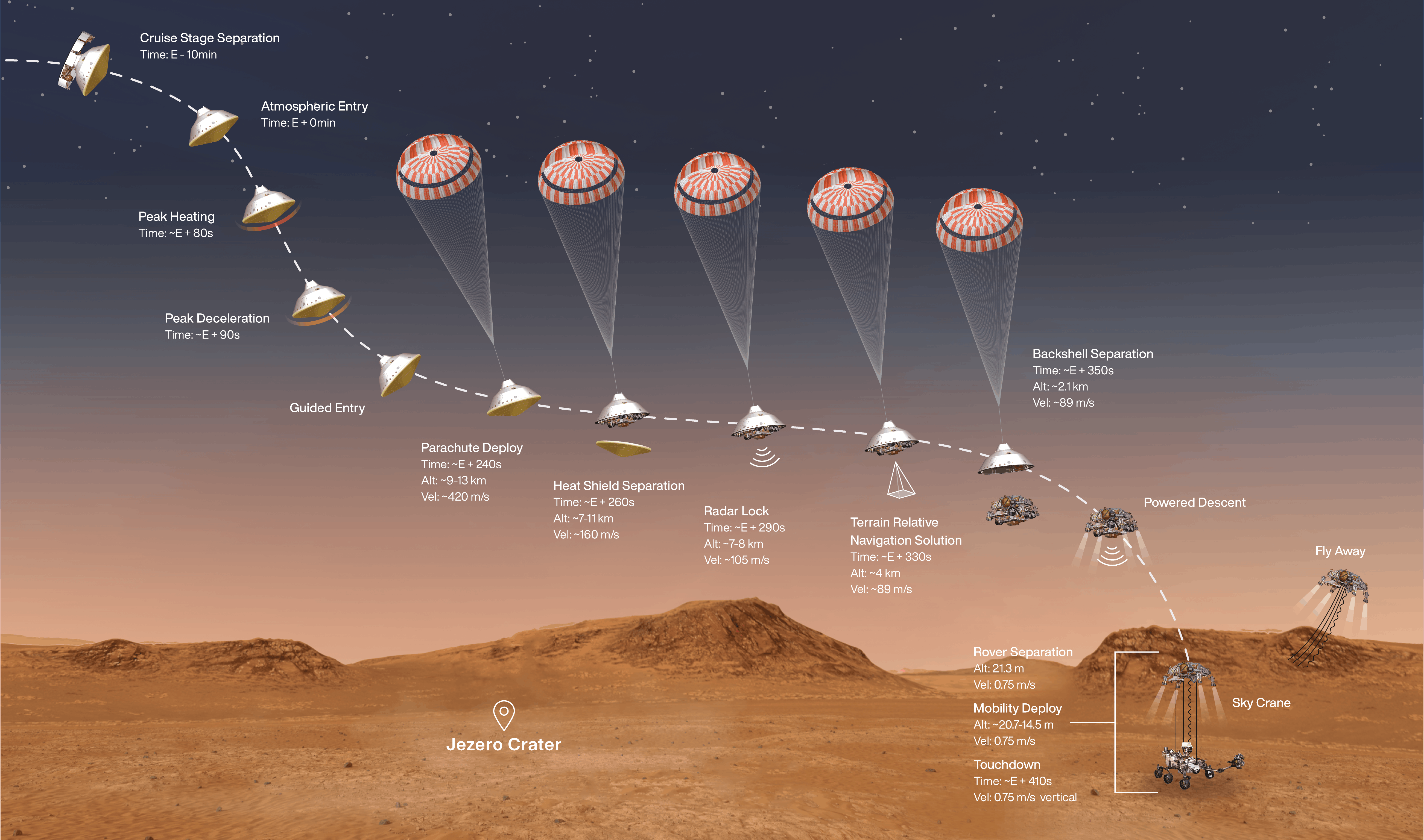
Source: NASA
It took about seven minutes for each rover to descend from the top of Mars’ atmosphere to the surface, and there’s a seven-minute communications delay back to Earth. This meant that by the time word got back to Earth that the capsule was entering the Martian atmosphere, the rover had already either touched down safely or been destroyed. In those seven minutes, there was no way NASA could’ve changed the actions of the descending rovers — thus the nickname “seven minutes of terror” for Mars landings.
The problem for Starship is there is no parachute big enough to slow its descent, and there will be no sky crane that can gently “place” the ship onto the surface. It will need to perform this descent of terror all on its own, in radio silence.
The leading strategy for getting Starship to touch down safely is to dip very low into the Martian atmosphere in a “belly flop” maneuver and make the most out of the thin atmosphere. The main idea behind this maneuver is to have as much surface area of the spacecraft as possible pushing against the atmosphere. Once the descent speed is small enough, the Starship can engage its boosters to achieve a gentle touchdown.

Source: Teslarati
Clearly, there is zero margin for error here. If even a single thing goes wrong, the entire mission will likely fail. The violence of the landing process also underscores the importance of selecting an appropriate landing site. There will be no landing pads on Mars for the first ships.
This means the terrain selected will need to withstand the impact and heat of Starship’s descent. Landing over an ice sheet that might melt and destabilize the terrain would be something to avoid, for example.
Life Support Systems
The capabilities and design of the spacecraft that will take humans to Mars are the starting point around which most manned missions are being planned. With that said, there are still many open design questions regarding exactly which kinds of systems, what kind of equipment, and how much of it should be brought to Mars on the first manned mission. It is difficult to build precisely with so many questions still outstanding. However, the best way to hedge against this uncertainty is to build a transport vehicle with as much capacity as possible.
This is the core idea behind SpaceX’s Starship. The ship is being designed with the ability to deliver 100 metric tons to the surface of Mars. This capacity constraint will become one of the core contours of our manned mission plans. A further constraint will be the minimum amount of resources and equipment human travelers will need to conduct and survive the six-month journey to Mars, the initial stay, and the return journey back to Earth.

Source: NASA
According to research conducted by NASA, one person requires something on the order of 11.3 metric tons of consumables per year. This includes an allotment for oxygen, food, and water for drink, food preparation, and hygiene purposes.
A Starship carrying humans to Mars will need to provide enough consumables to sustain a crew during their six-month trip to Mars, and also be retrofitted with life support systems required to maintain crew health both during transit and during the duration of their stay there. It will therefore need to become a miniature ecosystem capable of delivering essential inputs for life, while also carrying out functions like waste management, air filtration, pressure and temperature stabilization, and radiation protection.
These systems will need to be as lean as possible, ideally lightweight, and capable of recycling most inputs with a high degree of efficiency. Transporting all the oxygen, water, and food needed for a multi-year stay to Mars may be possible, but it will be highly uneconomical and won’t allow for a self-sufficient settlement.
This is why teams, particularly at NASA, have been studying the development of regenerative life support systems capable of redirecting as many waste products into useful inputs as possible.
Similar systems are already in operation aboard the International Space Station, which features a water recovery system, an air revitalization system, and an oxygen generation system. The ISS’s water recovery system can recycle 90% of all the water used on the station by funneling wastewater, crew member urine, and even humidity collected from the cabin through a number of multi-filtration beds and a catalytic oxidizer.

Source: Williams, Dake, et. al
In addition, the air revitalization system removes all potentially harmful fumes and exhaled carbon dioxide, while the oxygen generation system takes that exhaled carbon dioxide, strips the carbon atoms off, and funnels pure oxygen back into the cabin.
These systems, along with a number of airlocks, also help maintain the internal pressure of the ISS at around 1 bar, similar to atmospheric pressure at sea level.
The spacecraft carrying humans to Mars will need to be equipped with all these systems and more. Notably, protection will be needed against radiation. On Earth, we’re shielded from radiation by our planet’s magnetic field. However, in interplanetary space, exposed spacecraft are particularly vulnerable to powerful bursts of radiation, notably from solar flares, which can be lethal to humans.
One of the most difficult systems to engineer in a closed loop is the food system. On Earth, the best technology capable of sustainably recycling waste and exhausted gasses like carbon dioxide into useful materials is plants. However, plants grow slowly and certainly won’t be able to be grown at the scale required to service the daily nutrition needs of a crew on a journey to Mars.
On the ISS, all of the food is brought up from Earth. Waste is stored and expelled or returned. A Martian spacecraft, however, will not have a ready supply chain with Earth. While the Starship will have enough cargo capacity to sustain a 15-person crew during a six-month trip to Mars, ideally, work can be done to engineer systems that will close the loop on waste and food production as much as possible.
There is already rather interesting work being done to leverage genetically engineered yeasts that can produce various kinds of nutrients on demand.
The efficiency of such systems will also help determine the optimal number of crew members to take on the long journey to the Red Planet. Though initial NASA missions envisioned limited crews of three to six travelers, experience has demonstrated that having larger groups can be critical for psychological well-being. Proposed mission architectures based around the Starship envision sending 10-20 passengers per ship.
Preparing for a Manned Mission
Of course, there will be a great deal of infrastructure required to support the first humans on Mars, so a great deal of logistical work and preparation will need to be done ahead of time to prepare for their arrival. Essentially, this means sending a number of unmanned missions to Mars, not only to test and perfect a Martian landing but also to de-risk key technologies required for the establishment of a settlement.
The most critical factor in the success of a Martian settlement will be the ability to make use of resources already available on the planet. This is known as in-situ resource utilization, and it is a tactic that was first described by Robert Zubrin in his Mars Direct mission plan in 1990. For example, determining how to extract and convert water into useful materials will be one of the most important problems to figure out ahead of human arrival.
A more recent mission plan, outlined by NASA researchers in 2021, noted that assessing the exact nature of ice stores near the planned Martian settlement will be key to determining what kinds of machinery we’ll need to access the buried ice. Nearly all ice on Mars is covered by layers of rock or regolith. Assessing the depth of these rock layers will be critical since it will inform whether we will be able to drill past the rock to access the ice or whether alternative techniques, like explosives, will be required to unearth it.
Currently, many of the leading techniques for producing usable water from ice come from expeditions to Antarctica. It was there that mechanisms like the Rodriguez well or Rodwell were first developed. This method involves drilling into and melting ice in the subsurface to create a pool from which liquid water can be pumped up.
Since 1995, the Rodwell method has provided tens of millions of liters of water to the US South Pole Station, and the hope is that something similar can come into handy on Mars. Honeybee Robotics, a subsidiary of Blue Origin, has already begun developing concepts for a robotic driller that can produce Rodwells on Mars.
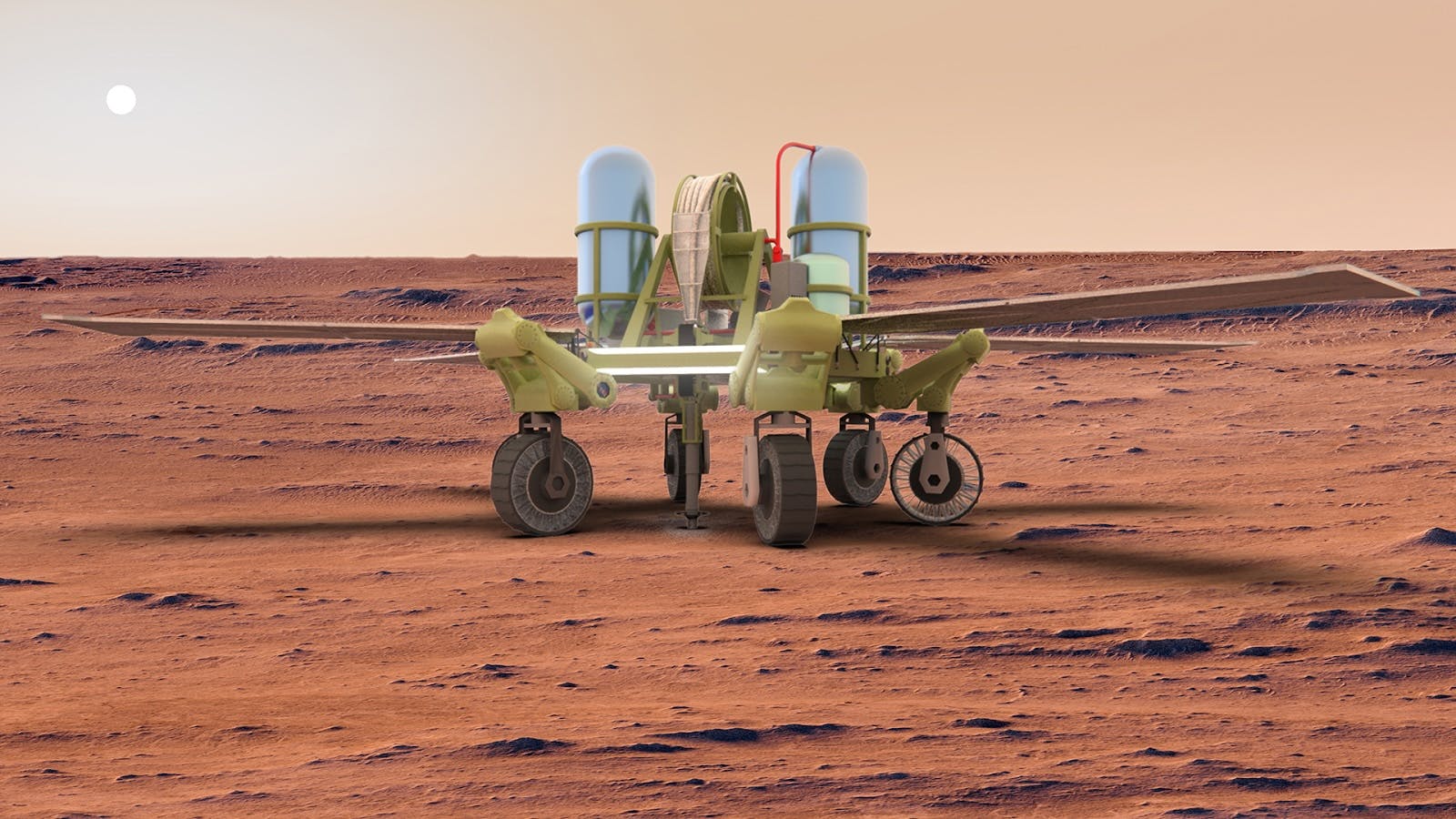
Source: JetPortal
Water will be essential not only for human consumption, but for all Martian industrial activities including manufacturing, construction, agriculture, future terraforming efforts, and critically, the production of propellant.
Methane is the fuel that will get humans on and off Mars, and it can be synthesized using well-known techniques established on Earth. With the Sabatier reaction, for instance, we can react carbon dioxide and hydrogen gas, to produce methane.
The carbon dioxide needed for such a process can be acquired readily from the Martian atmosphere, but hydrogen will need to be sourced from splitting water molecules into hydrogen and oxygen gas through electrolysis.
The Starship’s Raptor engines have already been designed to rely on methane fuel and oxidizer with the express goal of re-fueling the ship on Mars through the local production of methane propellant. To complete a return mission to Earth, Starship will require 267 metric tons of methane and 933 metric tons of oxygen, and it is essential that the ability to synthesize such quantities of propellant be demonstrated before the arrival of humans. The amount of water required to produce these quantities of fuel will be on the order of 600 metric tons, or, as the 2021 mission architecture estimates, an ice cube with 9 meter-long sides. A degree of foresight and planning will also be required to determine how the excavated water or ice will be transported to the electrolysis reactors, and in which form the water will be stored.
Another consideration that will need to be sorted out ahead of time is the installation of power infrastructure. Both the electrolysis reaction needed to split water and the Sabatier reaction needed to produce methane will require an input of energy, likely to be provided by solar panels initially. This is another core piece of infrastructure that may need to be established and proven out during initial unmanned missions.
Ensuring a reliable system of power provision, complete with backups, will be of the essence to survive on Mars. Solar panels will be a useful first step, however, they will be susceptible to a number of challenges on Mars, particularly dust storms. The Opportunity rover, active since 2004, was killed in 2018 during a global dust storm that blocked the rover’s solar panels and depleted its battery. This sad incident shows the importance of backup systems and the need to deploy more durable alternatives like nuclear reactors in the future.
Modular nuclear reactors, which are being actively developed today, can be a great resource for future Martian settlements. Gen4 Energy’s modular reactors, though no longer in business now, were a good example of a reactor design suitable for shipment to Mars. They weighed less than 40 tonnes and could produce up to 25 MW of power.
Lastly, establishing and testing communication systems on Mars will also be essential. Careful system design will be required here, especially since electrical components can be vulnerable to radiation and other challenges on Mars, so contingencies like this will need to be accounted for.
The First Martian Settlement
By the time humans set foot on Mars, there should ideally already be a significant amount of infrastructure and tools waiting for them. A number of Starship vehicles should be parked at the base, having delivered equipment during previous unmanned missions. Previous missions may also have delivered stores of additional food or water supplies for use by the crew in case of emergency and for the return journey.
These Starships will comprise some of the first human architecture on Mars. They will serve as the first habitats for Martian pioneers and as storage facilities. Complete with the life support systems discussed earlier, they will also serve as safe harbors capable of preserving a livable environment internally.
When humans wish to exit the Starship habitats, they will need to be properly outfitted to shelter themselves from the environmental conditions. It will be cold. They will need constant provision of oxygen which will set the limit for how long they can exist outside the habitat, just as a scuba diver’s tank sets the limit for how long divers can spend underwater. And that’s just the beginning.
Crucially, humans will also need protection from the lack of atmospheric pressure. Atmospheric pressure on Mars is 0.006 bar, which is 100 times lower than that on Earth. It is also far below the “Armstrong limit”, which at 0.068 bar, sets the threshold at which point the body’s surface fluids boil. Everything that is exposed to the air, including saliva, tears, and the fluids wetting alveoli in the lungs and delivering oxygen, will spontaneously turn into gas. This will make the delivery of oxygen into the body impossible, and within 90 seconds, death is a certainty. To avoid this, all outside activities on Mars will have to be conducted in pressurized suits.

Source: NASA
The pressurized suit is essentially a bubble, which must be inflated with enough gas, typically pure oxygen, to allow the astronaut to breathe and do some aerobic work. Astronauts at the International Space Station have spacesuits pressurized to 0.3 bar, which is something like the atmospheric pressure at the summit of Mount Everest. The difficulty of pressurizing the suit to 1 bar, which is what we find at sea level on Earth, is that the suit would be so rigid that articulated movement would be nearly impossible.
A further difficulty for maneuverability will be the lower gravity on Mars. Martian gravity is one-third that of Earth’s, which means that humans will be able to jump higher, though having a firm grasp on the ground will require practice.
Rovers will come in handy with maneuvering to critical points around the base. Given the risk of sending humans to Mars, the goal will be to enable them to be as productive as possible and save only the highest value, most difficult tasks for human beings. Anything that does not strictly require human involvement should ideally be done by a robotic assistant. Just like NASA’s Perseverance rover is equipped with a number of tools, from ground penetrating radar to various sensors used to perform different functions, future rovers could double as transport vehicles, and also conceivably be equipped with arms capable of deploying heavier objects like solar panels and cargo.
Some of the highest-value objectives for the first humans on Mars will be to expand the industrial capabilities and layout of the base. This will involve ensuring all industrial activities have backup power sources, enabling the transport of key industrial outputs like water from ice wells, and methane and oxygen products into the proper storage areas.
It will also involve building out infrastructure to support future Starship landings. As mentioned, any landing Starships will surely cause powerful dust storms and the force of their thrusters could easily catapult rocks and debris outwards at 3-4 times the speed of sound. These landings must be close enough to the base to ensure that the transport of goods can be performed efficiently, but also not damage the precious infrastructure already on the base. Crews with civil engineering experience will be needed to help oversee the construction of roads, landing, and launch pads.
Another key activity humans can help prove out is the viability of food production on Mars. As we know from experience on Earth, plants can be finicky and temperamental. However, efforts have already succeeded at growing plants in space. The Vegetable Production System (VEGGIE) aboard the ISS has shown that low-gravity hydroponic food production can work. However, experimentation will be required to determine how conditions like higher carbon dioxide levels, lower light, the possible presence of radiation, and soil chemistry, will need to be tweaked to produce adequate yields.

Even though the long-term goal will be to establish a self-sustaining Martian base capable of utilizing resources in situ, a great deal of equipment will need to be transported to Mars from Earth. Of course, transport won’t just be a one-way affair. The real hope is that Mars will one day become a source of valuable minerals and materials that can be brought back to Earth creating a regime of interplanetary trade.
However, before this happens, a lot of upfront investment will be required. Elon Musk has estimated that building a city on Mars will require getting something like a million tons of useful cargo to its surface — or 10,000 fully loaded Starships.
The sheer scale of this operation dictates that the Starships be manufactured en masse. Already, SpaceX has begun the buildout of a massive factory at Starbase that will one day produce one Starship per day. This is unprecedented speed in the aerospace world, but even with this production timetable, it will take 27 years to produce enough Starships to send to Mars. Elon Musk will be 79.
Longer-Term Martian Horizons
In an ideal future, humans won’t always need tons of equipment to brave the Martian outdoors. One can envision a Mars that is green; a planet with flowing rivers, where humans can shed their pressure suits and walk around freely!
The most important feat we’ll need to accomplish to realize this vision is increasing the heat energy of the planet. Currently, average temperatures on Mars sit at -60 °C. At this temperature, water is frozen. The low atmospheric pressure also makes molecular reactions nearly impossible, imposing a massive barrier on life. Therefore, the first step for introducing any kind of agricultural or bacterial life is increasing the planet’s average temperature to above freezing, where water — the universal solvent — can exist in a liquid state on the surface.
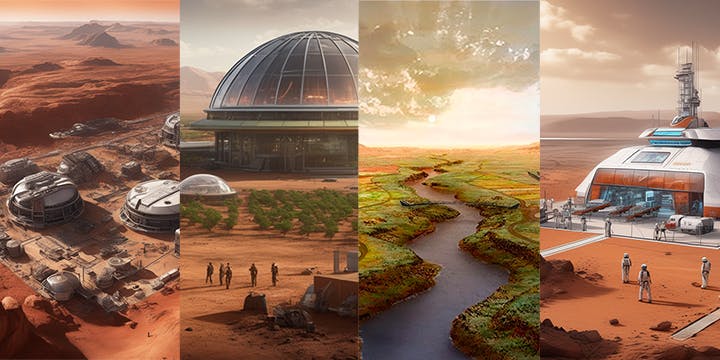
The question is how exactly this can be achieved. As on Earth, the primary source of heat on Mars is the Sun. However, unlike Earth’s atmosphere, which traps much of the heat inside to warm the planet, the Martian atmosphere is so thin that much of this heat simply escapes out into space. Thus, the best approach to producing a higher stable temperature on Mars will involve thickening the atmosphere by creating a greenhouse effect.
There are numerous molecules, including carbon dioxide, methane, ozone, nitrous oxide, and chlorofluorocarbons that make for effective greenhouse gasses on Earth. However, building up the Martian atmosphere sufficiently with these gasses would be a heavy lift — literally.
As astrobiologists Christopher McKay and Margarita Marinova have written, “the mass of just 0.1 Pa of atmosphere on Mars is 4 x 10^9 tons—much larger than the few hundred-ton payload of a large rocket to low Earth orbit.” Transporting gasses in this quantity to Mars will be infeasible, so the production of warming greenhouse gasses to beef up the Martian atmosphere and warm the planet will need to be done in situ.
As such, much of the exercise of terraforming Mars will come to an exercise in accounting. Taking stock of the molecules that exist on the planet, and understanding which of them can be effectively converted into greenhouse gasses in the necessary vast quantities.
In 1993, Robert Zubrin and Christopher McKay estimated the amount of frozen carbon dioxide contained in the subsurface and south polar cap of Mars using data from the Viking satellite. According to the estimate, enough was present that by adding heat to the system, we might plausibly trigger a runaway greenhouse effect. However, later studies seemed to contradict these estimates, by projecting much smaller stores of carbon dioxide existed than previously thought.
This is another reason why additional reconnaissance missions will be required before a self-sustaining colony can be established — to help produce more accurate estimates of carbon dioxide stores. But even if it turns out there isn’t enough carbon dioxide under the surface, other solutions might be possible.
One alternative approach suggested by Margarita Marinova, a prolific astrobiologist who held roles at NASA and SpaceX, would be to flood the Martian atmosphere with perfluorocarbons, a much more potent molecule than carbon dioxide capable of trapping even more heat. However, under this plan, the perfluorocarbon would need to be industrially manufactured by mining fluorite minerals on Mars and reacting them with carbon. The scope and complexity of this approach would be much greater than merely melting some frozen carbon dioxide ice, and it would require many decades to scale.
Even if, after a century, the Martian atmosphere can be warmed to above freezing, there still remains a question of how the water on Mars would behave after it became liquid. The Earth, for instance, has a stable hydrological cycle. Here, water evaporates into the atmosphere and rains or snows back down where it then collects in rivers and waterways again.
Mars may be quite different. Casey Handmer notes that mountains on Mars are so high, that any water that snowed there would just accumulate in glaciers, actually removing the liquid water from the system. What’s more, these glacier formations could then end up reflecting more of the sun’s heat into space — cooling the planet all over again.
If the effort to transform Mars successfully results in a warmer, thicker atmosphere where humans can walk or jump around the planet without pressure suits, they would still need a supply of breathable oxygen. To do this, a large fraction of the Martian atmosphere would need to be converted from carbon dioxide to oxygen. Whereas thickening the atmosphere might take something like 100 years to accomplish, Christopher McKay and Margarita Marinova have estimated that producing a fully oxygenated Martian atmosphere would require something more like 100,000 years.
Furthermore, due to Mars’s lower gravity, a breathable environment would actually require more oxygen, on a per-area basis, than on Earth. Adding massive amounts of oxygen to the atmosphere will require a careful balancing act. Handmer notes that removing carbon dioxide from the atmosphere for conversion to oxygen would detract from the greenhouse effect produced by the carbon dioxide gas.
It’s also unclear what the minimum viable composition of Martian air should look like for breathability. A pure oxygen environment would be highly flammable. On Earth, this is mitigated by an atmosphere of mostly buffer gasses. Nitrogen makes up 70% of the air, for instance. Interestingly, astronauts aboard Skylab lived up to 84 days in a cabin with a mixture of 70% oxygen and 30% nitrogen, which was fine for breathability, but meant that no flammable materials, like paints, could be brought on board.
Finding an adequate composition of buffer gasses for a breathable Martian atmosphere will be another interesting challenge in need of solving in the generations to come.
Transform Mars, Transform the Earth
Settling Mars is a kaleidoscopically complicated task, requiring input from every field of knowledge we have.
The feats it will require just to get there, from engineering orbital refueling to figuring out how to stick the landing, are monumental.
That’s not to mention the technologies that will be needed for humans to turn Mars into a habitable home. Pulling that off will require nothing short of replicating and compressing all of our industrial capabilities into their most efficient, compact forms — on another planet, tens of millions to hundreds of millions of miles away. Everything we’ve ever done bundled up.
Getting to Mars ties in physics, mathematics, biology, chemistry, structural engineering, material science, and more. For this reason, there’s almost nothing that NASA doesn’t research.
The knowledge that will spring from completing a mission to Mars may well end up transforming our planet, too. The regenerative life support systems developed for the crew can teach us how to fruitfully reuse as many of our waste products as possible. Building autonomous robots capable of performing complicated tasks on Mars will refine our robotics capabilities with wide implications. Learning how to swiftly and efficiently engineer strong materials in situ will help increase the efficiency of terrestrial industrial activities as well.
The mission to Mars is a forcing function for us to test the limits of what we can build with our current knowledge, and expose the gaps in our understanding. It’s also a feat that will take decades upon decades of work and with a timeline so far into the future, the best way to ensure humanity becomes a multi-planetary species is to prioritize the mission now.
This piece is indebted to the work done by many brilliant engineers, astrobiologists, and physicists.
For further reading and a more in-depth treatment of some of the technical challenges we’ll face settling Mars, please consult the books that Casey Handmer has written on the subject. To understand more of the background of planning a Mars mission, please consult the books of Robert Zubrin, who was the first to propose in-situ resource utilization, or “living like a Martian.” Lastly, the papers of Christopher McKay and Margarita Marinova are instructive for understanding the contours of a first manned mission to Mars, and also the prospects of terraforming the Red planet.
Disclosure: Nothing presented within this article is intended to constitute legal, business, investment or tax advice, and under no circumstances should any information provided herein be used or considered as an offer to sell or a solicitation of an offer to buy an interest in any investment fund managed by Contrary LLC (“Contrary”) nor does such information constitute an offer to provide investment advisory services. Information provided reflects Contrary’s views as of a time, whereby such views are subject to change at any point and Contrary shall not be obligated to provide notice of any change. Companies mentioned in this article may be a representative sample of portfolio companies in which Contrary has invested in which the author believes such companies fit the objective criteria stated in commentary, which do not reflect all investments made by Contrary. No assumptions should be made that investments listed above were or will be profitable. Due to various risks and uncertainties, actual events, results or the actual experience may differ materially from those reflected or contemplated in these statements. Nothing contained in this article may be relied upon as a guarantee or assurance as to the future success of any particular company. Past performance is not indicative of future results. A list of investments made by funds managed by Contrary (excluding investments for which the issuer has not provided permission for Contrary to disclose publicly as well as unannounced investments in publicly traded digital assets) is available at www.contrary.com/investments.
Certain information contained in here has been obtained from third-party sources, including from portfolio companies of funds managed by Contrary. While taken from sources believed to be reliable, Contrary has not independently verified such information and makes no representations about the enduring accuracy of the information or its appropriateness for a given situation. Charts and graphs provided within are for informational purposes solely and should not be relied upon when making any investment decision. Please see www.contrary.com/legal for additional important information.

